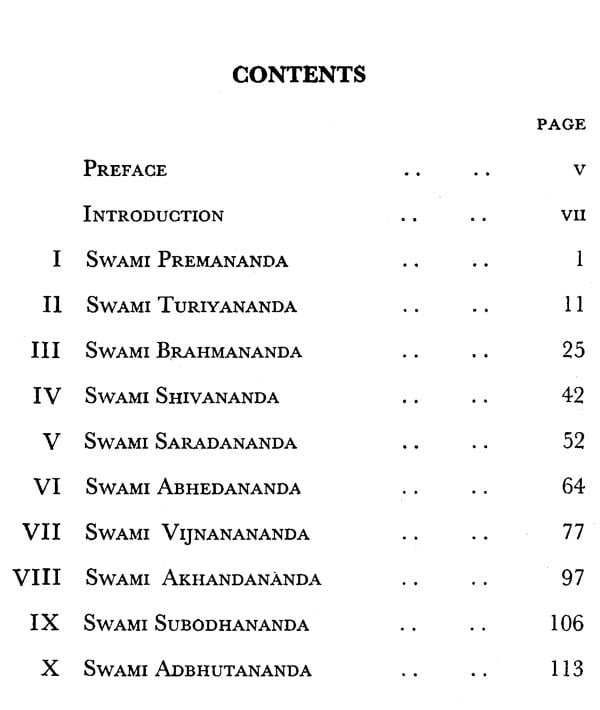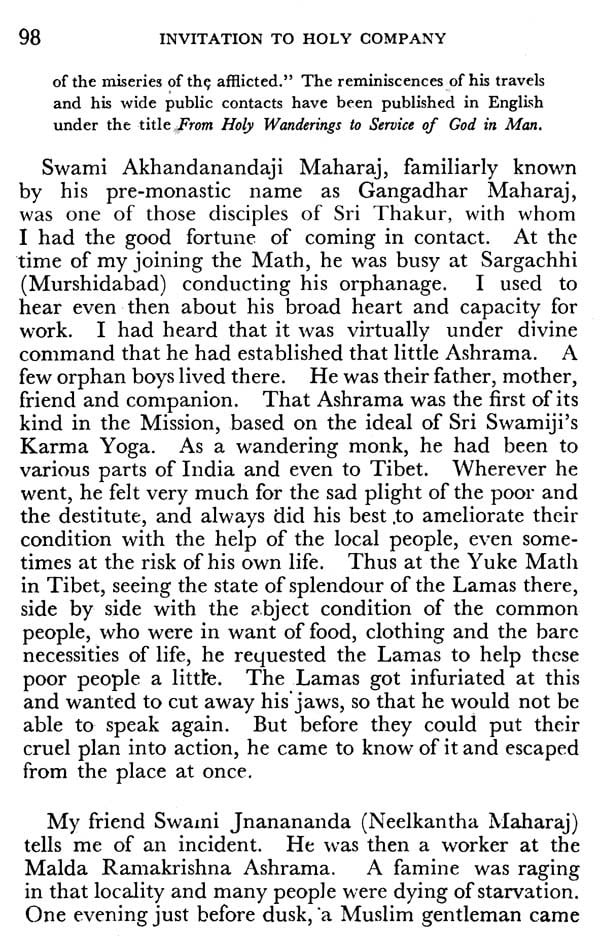
Invitation to Holy Company
Book Specification
| Item Code: | AZC346 |
| Author: | Swami Jnantmananda |
| Publisher: | Sri Ramakrishna Math |
| Language: | English |
| ISBN: | 8178233835 |
| Pages: | 192 |
| Cover: | Paperback |
| Other Details | 7 x 5 Inches |
| Weight | 121 gm |
Book Description
This little book is a free translation of Punyasmriti (Sacred Memories) in Bengali written by myself and published from the Udbodhan Office, Calcutta. It contains my humble reminiscences of ten of the direct Saimyasin disciples of Sri Thakur (Sri Ramakrishna). I firmly believe that on account of some good merits in my previous births, I had the rare good fortune to sit at their feet and enjoy their holy company in various ways. The booklet is written mainly for purifying my soul, but I trust it will also benefit those who will read it and deeply ponder over its contents. As Sukadeva says in the Srimad Bhagavata to king Parikshit awaiting his death in a week, "0 King, just as the holy Ganges flowing from the feet of the Lord Vishnu purifies the three worlds consisting of the Heaven, the Earth, and the Nether World (Patala), so also the discourses on the life and plays (Lila) of Vasudeva purify alike all the three concerned - the speakers, the listeners, and those who ponder over it."
This small book, too, I hope, will serve the same purpose.
May the Lord Bless us all!
Invitation to Holy Company is the work of a life-long Sannyasin, recording his intimate experiences with ten of the direct monastic disciples of Sri Ramakrishna, who may be designated as the Great Master's Apostles. They are fifteen in number, excluding Swami Vivekananda and the Holy Mother, but fiver of them does not find a place here, because they had left their mortal coils before the writer had joined the monastic Order.
Readers of the Ramakrishna-Vivekananda literature, as a rule, feel that they have exhausted their study of the subject by reading the lives and works of the Holy Three - the Great Master, Swamiji and the Mother. This is an incorrect and imperfect view. The Great Master speaks to mankind through all those whom he made his 'own'. These fifteen are all included in that category. The Great Master is like a mighty tree. His roots are in the unseen, the infinite and the absolute Being, and he rises as a mighty tree before man's vision, dividing himself into several main branches, of which no doubt the most massive are the Holy Mother and Swami Vivekananda. But there are several other substantial off-shoots from that tree adding to its foliage, its fruitage and the extensiveness of the protective shade it affords. These disciples are such branches, and a full study of the Master and his message requires an understanding of the life, personality and teachings of these disciples too.
It will be found that the variety of talents and of personality-types represented by these disciples is as varied as the phases of the Master's spiritual genius itself. In Swami Premananda we get a personality rich in faith, love and gentleness; in Swami Brahmananda, one who ever lived in the Atman-consciousness but yet possessed an all-sided wisdom that could solve any complicated problem of monastic administration or organisational work; in Swami Turiyananda, a stern Vedantic ascetic whose austere nature always held the body in subordination and who remained aloof from all concerns of the world but yet was full of love and fellow-feeling for men; in Swami Shivananda, a tower of spiritual strength ever surrounded by an aura of love and knowledge but yet actively concerned with the welfare of men; in Swami Abhedananda, an erudite scholar and an ascetic missionary who spent the best part of his life in preaching the Vedanta abroad; in Swami Vijnanananda, a true Vijnani, who, having ascended the summits of enlightenment, none the-less adopted the nature of an innocent child (Pandityam nirvidya balyena tisthaset) ; in Swami Akhandananda, an intrepid pilgrim and devout contemplative turned later into a servant of God in man; in Swami Subodhananda, one who ever remained a 'boy' in spite of his wisdom; in Swami Saradananda, a scholar-Sannyasin of unperturbed temperament with unparalleled capacities for shouldering onerous responsibilities, and in Swami Adbhutananda, a village shepherd boy turned by the Master's magic touch into a great Sannyasin and a man of wisdom.
These great disciples with such diverse talents, capacities and backgrounds were forged into a unified spiritual Brotherhood by the love of the Great Master and the sense of a 'mission' that he imparted to them. Generally the disciples of a spiritual personage of ordinary calibre seek their own individual spiritual purposes and move apart after the teacher's demise. It is only the Incarnations, the teachers commissioned by the Divine, that could impart to their disciples a sense of Brotherhood, consolidated by the cement of mutual love and respect, and a feeling of commitment on their part to preserve and transmit certain spiritual values and experiences that their venerable teacher had handed over to them. Human relationship, even at higher levels, is plagued with innumerable vicissitudes caused by clash of personalities and man's sense of self-importance, and it is only mutual love, tolerance and a reverential allegiance to a common cause that can overcome the tensions generated thereby. A spiritual Brotherhood is the end-product of countless acts of self-sacrifice and self abnegation, of forgiving love and unflinching faithfulness. Only souls, afire with divine love and the urge to share the experience of it with others in all humility and self-effacement can forge its links. It is such a spiritual Brotherhood, brought into existence by these direct disciples under the influence of the creative warmth of the Master's love, which has provided the cultural vehicle for the preservation and transmission of the spiritual efficiencies brought into being by the Great Master.
A proper understanding of these great disciples in the right perspective is therefore a 'must' for any deep student and sincere devotee of Sri Ramakrishna's life and message. All the great incarnations reveal their message as much through the type of loving relationship they maintain towards their associates as through the verbal instructions they impart. If Rama is to be understood, one has to go into his relationship with Sita, Lakshmana, Hanuman, Vibhishana, etc., and so a study of him includes a study of them too. The same is the case with Sri Krishna, the Buddha, Chaitanya and other Incarnations, including the Great Master.
**Contents and Sample Pages**











